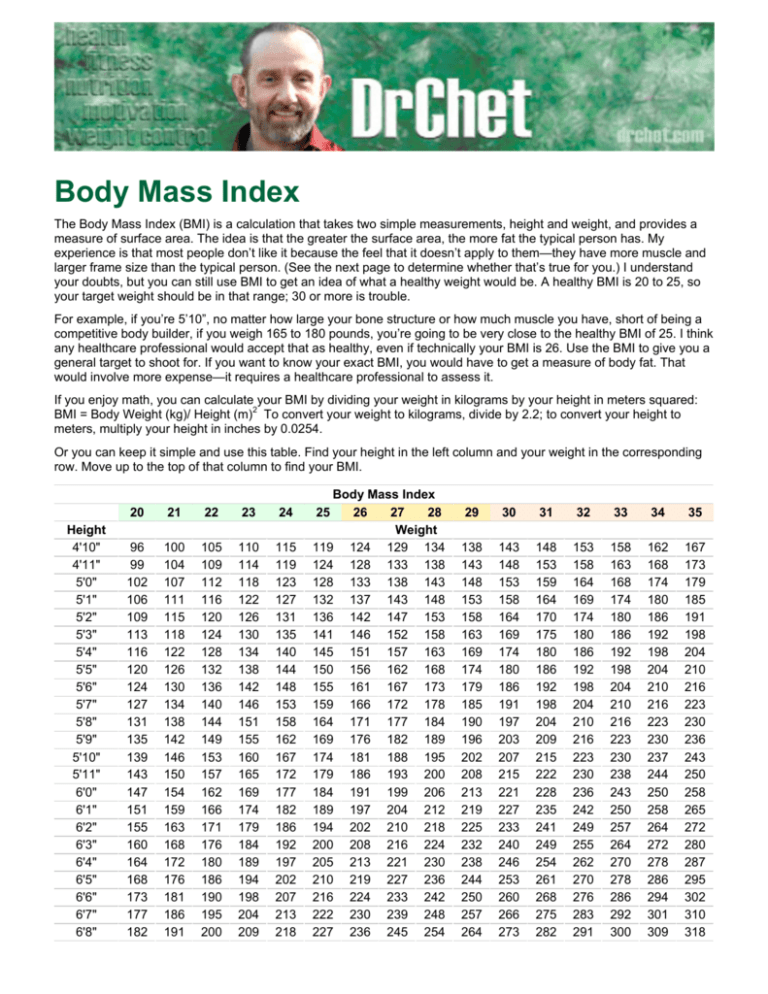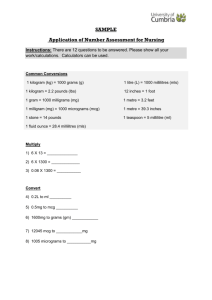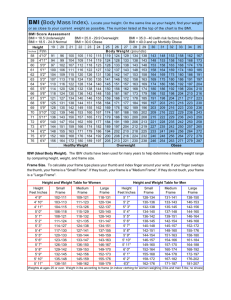Body Mass Index
advertisement

Body Mass Index The Body Mass Index (BMI) is a calculation that takes two simple measurements, height and weight, and provides a measure of surface area. The idea is that the greater the surface area, the more fat the typical person has. My experience is that most people don’t like it because the feel that it doesn’t apply to them—they have more muscle and larger frame size than the typical person. (See the next page to determine whether that’s true for you.) I understand your doubts, but you can still use BMI to get an idea of what a healthy weight would be. A healthy BMI is 20 to 25, so your target weight should be in that range; 30 or more is trouble. For example, if you’re 5’10”, no matter how large your bone structure or how much muscle you have, short of being a competitive body builder, if you weigh 165 to 180 pounds, you’re going to be very close to the healthy BMI of 25. I think any healthcare professional would accept that as healthy, even if technically your BMI is 26. Use the BMI to give you a general target to shoot for. If you want to know your exact BMI, you would have to get a measure of body fat. That would involve more expense—it requires a healthcare professional to assess it. If you enjoy math, you can calculate your BMI by dividing your weight in kilograms by your height in meters squared: BMI = Body Weight (kg)/ Height (m)2 To convert your weight to kilograms, divide by 2.2; to convert your height to meters, multiply your height in inches by 0.0254. Or you can keep it simple and use this table. Find your height in the left column and your weight in the corresponding row. Move up to the top of that column to find your BMI. Height 4'10" 4'11" 5'0" 5'1" 5'2" 5'3" 5'4" 5'5" 5'6" 5'7" 5'8" 5'9" 5'10" 5'11" 6'0" 6'1" 6'2" 6'3" 6'4" 6'5" 6'6" 6'7" 6'8" 20 21 22 23 24 96 99 102 106 109 113 116 120 124 127 131 135 139 143 147 151 155 160 164 168 173 177 182 100 104 107 111 115 118 122 126 130 134 138 142 146 150 154 159 163 168 172 176 181 186 191 105 109 112 116 120 124 128 132 136 140 144 149 153 157 162 166 171 176 180 186 190 195 200 110 114 118 122 126 130 134 138 142 146 151 155 160 165 169 174 179 184 189 194 198 204 209 115 119 123 127 131 135 140 144 148 153 158 162 167 172 177 182 186 192 197 202 207 213 218 Body Mass Index 26 27 28 Weight 119 124 129 134 124 128 133 138 128 133 138 143 132 137 143 148 136 142 147 153 141 146 152 158 145 151 157 163 150 156 162 168 155 161 167 173 159 166 172 178 164 171 177 184 169 176 182 189 174 181 188 195 179 186 193 200 184 191 199 206 189 197 204 212 194 202 210 218 200 208 216 224 205 213 221 230 210 219 227 236 216 224 233 242 222 230 239 248 227 236 245 254 25 29 30 31 32 33 34 35 138 143 148 153 158 163 169 174 179 185 190 196 202 208 213 219 225 232 238 244 250 257 264 143 148 153 158 164 169 174 180 186 191 197 203 207 215 221 227 233 240 246 253 260 266 273 148 153 159 164 170 175 180 186 192 198 204 209 215 222 228 235 241 249 254 261 268 275 282 153 158 164 169 174 180 186 192 198 204 210 216 223 230 236 242 249 255 262 270 276 283 291 158 163 168 174 180 186 192 198 204 210 216 223 230 238 243 250 257 264 270 278 286 292 300 162 168 174 180 186 192 198 204 210 216 223 230 237 244 250 258 264 272 278 286 294 301 309 167 173 179 185 191 198 204 210 216 223 230 236 243 250 258 265 272 280 287 295 302 310 318 Do you have a large frame? Many people excuse a little extra weight with the rationale, “I’m just big-boned.” Maybe, maybe not—let’s see if the science backs up your statement. According to studies that examined correlations between anthropometric measurements and BMI, body frame can have an impact on your BMI target. The simplest measure of frame size is your wrist circumference, which works at almost any weight because very little weight is gained in that spot compared to areas like the waist or hips. To determine your frame size, measure your wrist just below (towards the fingers) the bony part. Use the chart below to determine whether your frame size is large. If it is, shift your target weight one to two BMI units to the right on the chart; instead of 25, make the weight under 26 or 27 your goal, depending on the degree of difference. On the other hand, if your wrist is significantly smaller than the measurements below, you may be healthier at the target weight under 24 to 20 on the BMI chart. For women, frame size is based on your height and wrist measurements: If you’re under 5’2”, you have a large frame if your wrist is greater than 5.75 inches If you’re 5’2" to 5’5”, you have a large frame if your wrist is greater than 6.25 inches If you’re over 5’5”, you have a large frame if your wrist is greater than 6.5 inches For men over 5’5”, you have a large frame if your wrist is greater than 7.5 inches; there is no data available for men under that height.






